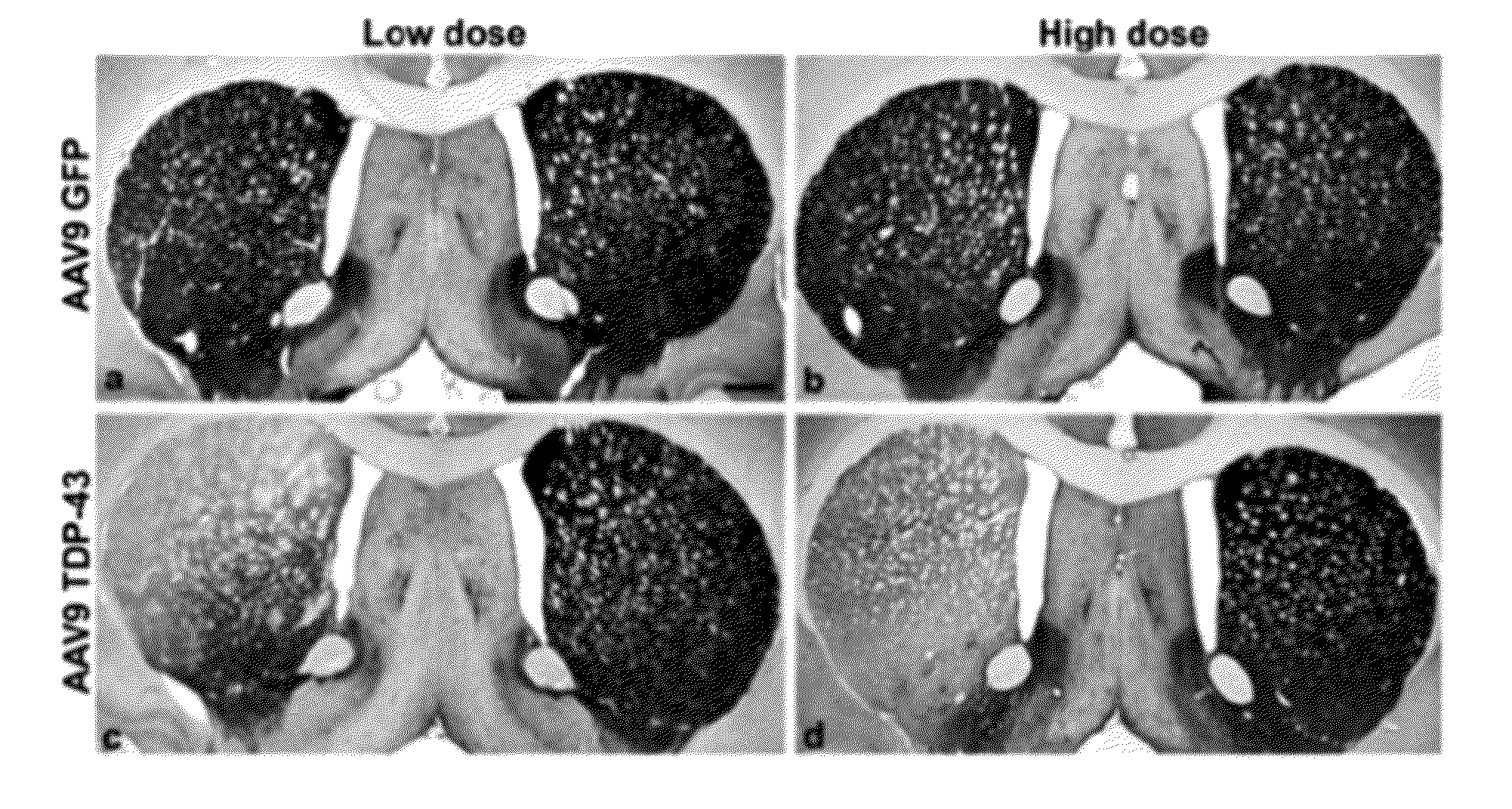Assays of Neurodegenerative Disorders, including Frontotemporal Dementia and Amyotrophic Lateral Sclerosis
a neurodegenerative disease and in vivo analysis technology, applied in the field of in vivo analysis of neurodegenerative diseases, can solve the problems of terminal illness, lack of treatment options for most neurodegenerative diseases, lack of effective neurodegenerative therapy, etc., and achieve good mimicry and wide spread of gene transfer
- Summary
- Abstract
- Description
- Claims
- Application Information
AI Technical Summary
Benefits of technology
Problems solved by technology
Method used
Image
Examples
example 1
Rat TDP-43 Assay
[0100]In order to expand FTLD modeling to a major fraction (50%) of the disease population, TDP-43 in was expressed rats, and a highly specific toxic gene product was observed, causing neuronal cell loss more readily than tau. The human wild type TDP-43 mainly expressed in neuronal nuclei as expected, but a small fraction of the transduced cells (estimated to be 1-2% of the total) expressed TDP-43 in the cytoplasm. Three such examples are shown at high power in FIG. 8A-C, with one example from the GFP group in FIG. 8D, using an antibody that recognizes both rat and human TDP-43. TDP-43 positive nuclei are in both groups, whereas the protein is only expressed cytoplasmically in the TDP-43 group, with diffuse and granular immunoreactivity at an interval of 4 weeks. Cytoplasmic ubiquitin deposition only occurred in the TDP-43 group, in the areas that had the cytoplasmic TDP-43 (FIG. 8H). There was evidence of abiotrophic, pyknotic degeneration by hematoxylin & eosin sta...
example 2
TDP-43 Expression in the Hypoglossal Nucleus
[0103]a) An assay which mimics symptoms of bulbar onset ALS can be provided using the methods for TDP-43 gene transfer to the hypoglossal nucleus disclosed herein. It is contemplated that focal delivery of TDP-43 to the rat hypoglossal nucleus will mimic a specific symptom of bulbar onset ALS (Eisen, 2009; DePaul et al., 1988) as described herein. Bulbar onset ALS with dysarthria has a particularly poor prognosis due to aspiration of food (Tomik and Guiloff, 2008). Dysarthria, or motor dysfunction of the mouth, is a key symptom of bulbar onset ALS, where the face, and talking, are affected (DePaul et al., 1988). The hypoglossal injections of AAV9 TDP-43 into rats induces a robust phenotype of decreased lick force, reminiscent of dysarthria.
[0104]The methods disclosed below test whether TDP-43 variants (NLS TDP, TDP-25) designed for cytoplasmic expression will also impair lick force. It is contemplated that while TDP-43 expression directed ...
example 3
[0109]Intravenous administration of TDP-43 AAV9
[0110]It is contemplated that widespread TDP-43 expression from intravenous vector delivery is relevant to diseases with widespread pathology. A method for gene transfer to the spinal cord, brain stem, and brain via intravenous vector administration is thus provided.
[0111]a) One day old rat pups were injected with GFP or TDP-43 AAV9 via the temporal vein with a 30 ga. needle. A high dose of AAV9 TDP-43 in neonatal rats caused a severe and rapid disease state as early as 3 weeks. Therefore, a low dose (9×10E11 vg) should permit a slower pathogenesis. Transduced rats can be maintained for 6 months for evaluating their behavior, as well as overall health and weight gain over 6 months. Behavioral testing intervals can be at 1, 2, 3, and 6 months before histological analysis at that interval, with 12 rats per group. Each vector group can have 6 rats sacrificed at 1 month for histology, which would not be run for behavior.
[0112]A dose-respons...
PUM
| Property | Measurement | Unit |
|---|---|---|
| time | aaaaa | aaaaa |
| thick | aaaaa | aaaaa |
| volumes | aaaaa | aaaaa |
Abstract
Description
Claims
Application Information
 Login to View More
Login to View More - R&D
- Intellectual Property
- Life Sciences
- Materials
- Tech Scout
- Unparalleled Data Quality
- Higher Quality Content
- 60% Fewer Hallucinations
Browse by: Latest US Patents, China's latest patents, Technical Efficacy Thesaurus, Application Domain, Technology Topic, Popular Technical Reports.
© 2025 PatSnap. All rights reserved.Legal|Privacy policy|Modern Slavery Act Transparency Statement|Sitemap|About US| Contact US: help@patsnap.com



